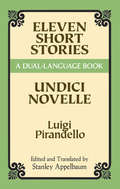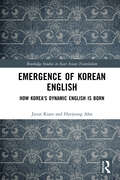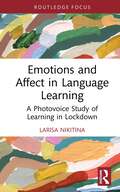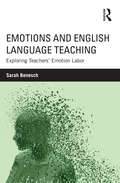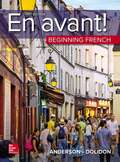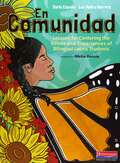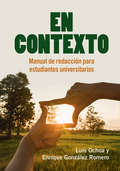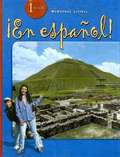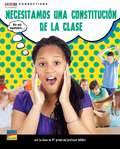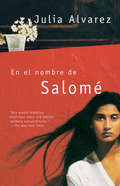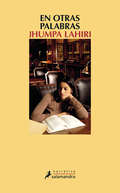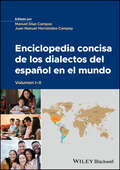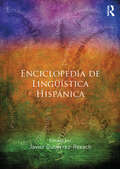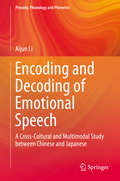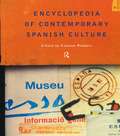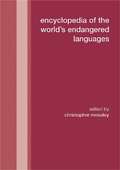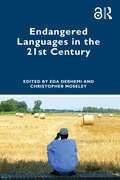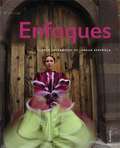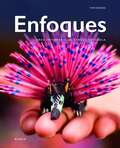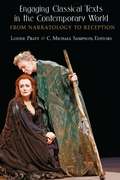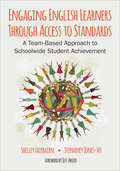- Table View
- List View
Eleven Short Stories: A Dual-Language Book (Dover Dual Language Italian)
by Luigi PirandelloWinner of the 1934 Nobel Prize for literature, Luigi Pirandello (1867 - 1936) is best known for such landmark plays as Six Characters in Search of an Author. One of the great literary figures of the twentieth century, he also distinguished himself in a vast outpouring of short stories, poetry, novels, and essays. The stories often provided the seeds for later novels and plays.The 11 tales included in this collection are among his best. Presented in the original Italian with excellent new English translations on facing pages, they offer students of Italian language and literature a unique learning aid and a treasury of superb fiction by a modern master.The stories range in time from the earliest known tale, "Little Hut," a study of rural passions written in 1884, to "Mrs. Frola and Mr. Ponza, Her Son-in-Law," a quintessential Pirandello story about the relativity of truth and the impossibility of penetrating other people's minds. Published in 1917, it formed the basis of Pirandello's first major play, Right You Are If You Think You Are. In addition to these narratives, the volume also includes "Citrons from Sicily," "With Other Eyes," "A Voice," "The Fly," "The Oil Jar," "It's Not to be Taken Seriously," "Think it Over, Giacomino!," "A Character's Tragedy," and "A Prancing Horse."Accompanying the stories are a biographical and critical introduction to Pirandello and his work, brief introductions to each of the stories and explanatory footnotes.
Embodied Conceptualization or Neural Realization: A Corpus-Driven Study of Mandarin Synaesthetic Adjectives (Frontiers in Chinese Linguistics #10)
by Qingqing ZhaoThis book focuses on linguistic synaesthesia in a hitherto less-studied language – Mandarin Chinese – and adopts a corpus-driven approach to support the analysis and argumentation. The study identifies directional tendencies and underlying mechanisms for Mandarin synaesthetic adjectives. By doing so, it not only provides an added layer of understanding for theories of linguistic synaesthesia, but also offers evidence to help refine previous theories, such as Embodiment Theory and Conceptual Metaphor Theory. In brief, the book makes a significant contribution to the development of Cognitive Linguistics. The intended readership includes, but is not limited to, graduate students in linguistics and researchers interested in Chinese linguistics in particular, and in lexical semantics and cognitive linguistics in general.
Emergence of Korean English: How Korea's Dynamic English is Born (Routledge Studies in East Asian Translation)
by Jieun Kiaer Hyejeong AhnEmergence of Korean English explores the dynamic nature of emerging Korean English and its impact on Korean society, culture, and identity. This book challenges the negative stereotypes and stigmatization of Konglish and argues that it has been a great asset for Korea’s fast economic development. The fate of Korean English has been transformed in the time of the Korean wave as the K-fandom actively engages with Korean English. The book offers a comprehensive overview of Korea’s encounter with the English language and provides an in-depth analysis of linguistic characteristics, pragmatic features, and cross-cultural and cross-linguistic aspects of Korean English. The authors examine the unique linguistic features of Korean English, including phonological, syntactic, and lexical features, and highlight the sociocultural implications of these features for Korean society. In addition, the book discusses the role of Hallyu fandom languages in the emergence of Korean English and the growth of Korean pop culture worldwide. It also provides insights into the English fever in South Korea and its impact on education, society, and culture. This book is a valuable resource for scholars, students, and professionals who are interested in the emergence of Korean English and its social, cultural, and linguistic implications for Korea and the global community.
Emotions and Affect in Language Learning: A Photovoice Study of Learning in Lockdown (Routledge Focus on Applied Linguistics)
by Larisa NikitinaThis book explores emotions and affect in language learning during total lockdown during the early phase of the COVID‑19 pandemic when all teaching and learning activities had to transition online. Having classes online and learning in lockdown was an unknown, disconcerting, and emotionally saturated experience for both the teachers and their students majoring in foreign languages.To explore this, the author conducted a study at a Malaysian university using perezhivanie, a concept introduced by Lev Vygotsky (1896–1934), as a theoretical foundation for pedagogically oriented research on affect and emotions. It refers to an intense emotional lived‑through experience that often leads to a qualitative change within an individual. To capture the students’ experiences of learning in total lockdown, she also employs photovoice methodology as an analytical approach. In her book, Nikitina demonstrates using the photovoice method to capture the emotional ebbs and flows inherent in perezhivania. The theoretical framework of perezhivanie and novel photovoice methodology adopted in this book can be employed in future explorations of emotional labours of students and their teachers in a wide range of educational settings.This book’s theoretical anchoring, robust methodology, and rigorous analysis of visual and linguistic data findings presented in this book will contribute to a better understanding of learning and teaching during challenging circumstances for students and academics of applied linguistics, psychology of language learning, or second language acquisition.
Emotions and English Language Teaching: Exploring Teachers’ Emotion Labor
by Sarah BeneschTaking a critical approach that considers the role of power, and resistance to power, in teachers’ affective lives, Sarah Benesch examines the relationship between English language teaching and emotions in postsecondary classrooms. The exploration takes into account implicit feeling rules that may drive institutional expectations of teacher performance and affect teachers’ responses to and decisions about pedagogical matters. Based on interviews with postsecondary English language teachers, the book analyzes ways in which they negotiate tension—theorized as emotion labor—between feeling rules and teachers’ professional training and/or experience, in particularly challenging areas of teaching: high-stakes literacy testing; responding to student writing; plagiarism; and attendance. Discussion of this rich interview data offers an expanded and nuanced understanding of English language teaching, one positing teachers’ emotion labor as a framework for theorizing emotions critically and as a tool of teacher agency and resistance.
Empowering EAL Learners in Secondary Schools: A Practical Resource to Support the Language Development of Multilingual Learners
by Joanna KolotaOne in five students are identified as speaking English as an Additional Language (EAL) and all teachers are highly likely to be teaching multilingual students in their classrooms. As our schools become more culturally and linguistically diverse, they must respond to the needs of the students in front of them, and this book provides a range of strategies and resources to ensure teaching is adaptive and responsive so that all learners thrive and fulfil their academic potential.At the heart of the book is developing an understanding of how languages are acquired and an awareness that all students, regardless of their current English language proficiency, need to be offered a challenging and supportive environment. Chapters offer: High-yielding, practical approaches and strategies to ensure that students are able to access content-appropriate lessons and simultaneously develop their language A plethora of resources and step-by-step examples, showcasing how explicit vocabulary and grammar learning can be context-based for the benefit of all learners Each teacher is positioned as a language teacher, with the responsibility of planning sessions where language is not perceived as an add-on, but as an integral and pivotal part. This book will empower you as an educator and ensure that your classroom is a language-aware and stimulating environment for your students. It will be essential reading for all secondary school educators and teaching assistants who support EAL students in mainstream lessons and are responsible for producing resources and implementing classroom strategies.
En Activo: Practical Business Spanish
by Esther Santamaria Iglesias Helen JonesEn Activo is a contemporary course which provides students with a structured development of written and spoken business language skills, focusing on real business people and situations from all over the Spanish-speaking world. The book consists of twenty chapters that incorporate contextual information on the business environment of Spain and Latin America, role-plays, illustrative dialogues, dedicated written exercises, relevant grammar instruction, practical communicative exercises, up-to-date practical advice, model items of written and spoken business protocol, and links to numerous carefully-selected and integrated websites. Each chapter is structured as follows: -Le Presento a…: introduction of the central individual and their working life -Escuche, por favor: extensive listening exercises and accompanying activities -Recuerde que...: grammar revision and communicative exercises -Para saber más: deepens knowledge about Spanish and Latin-American business culture and etiquette -Así se hace: hands-on section practising business situations and day-to-day tasks -¿Sabe navegar?: practices web research and web etiquette. Each fifth chapter is a revision chapter, which puts the acquired knowledge in practice via discussion groups, presentations and debates. The supporting website at www.enactivo.info features additional web and learning resources and exercises. An audio CD containing all interviews and listening comprehension exercises is available separately. At the end of this course the student will have a sound knowledge of the Spanish speaking business world and the language skills required to put this knowledge in practice.
En Avant!: Beginning French
by Bruce Anderson Annabelle DolidonLes étudiants apprennent mieux lorsqu’ils se connectent à la langue telle qu’elle est utilisée dans des contextes du monde réel, entre eux en tant que communauté et avec une culture authentique. En avant ! suscite la curiosité qui construit ces liens à mesure que les élèves progressent vers les compétences communicatives et culturelles dans la classe d’introduction. Le En avant! Le programme est construit autour des principes distinctifs suivants : * Une approche ciblée avec examen et recyclage systématiques* Apprentissage actif* Intégration de la culture Maintenant dans sa troisième édition, En avant! comprend de nombreux changements ciblés suscités par les commentaires des évaluateurs afin d'impliquer plus facilement les étudiants dans le contenu grammatical et culturel tout en rendant ce contenu encore plus convivial et logique. Dans notre processus de révision, nous avons mis l'accent sur la création et l'intégration de nouvelles fonctionnalités, basées sur les normes mondiales de préparation de l'ACTFL, afin de mieux engager et inspirer une nouvelle génération d'apprenants de français soucieux du numérique.
En Comunidad: Lessons For Centering The Voices And Experiences Of Bilingual Latinx Students
by Carla Espana Luz Yadira HerreraDrs. Carla Espana and Luz Yadira Herrera's schooling and teaching journey reveal the power of educators to create either liberating or dehumanizing spaces and experiences for bilingual Latinx students. En Comunidad brings bilingual Latinx students' perspectives to the center of our classrooms. Its culturally and linguistically sustaining lessons begin with a study of language practices in students' lives and texts, helping both children and teachers think about their ideas on language. These lessons then lay out a path for students' and families' storytelling, a critical analysis of historical narratives impacting current realities, ways to develop a social justice stance, and the use of poetry in sustaining the community. As the largest group of bilinguals in the U.S., bilingual Latinx students need teachers to not just welcome them into their classrooms, but also to advocate with and for them, for their languages, and for their lives. En Comunidad offers classroom-ready lessons that amplify the varied stories and identities of Latinx children. Each sequence of lessons follows a critical bilingual literacies framework for any educator teaching bilingual Latinx children and: - focuses on issues of language, literacies, and power - recommends carefully-curated texts and multimodal resources featuring Latinx voices - centers a translanguaging pedagogy that honors bilingual Latinx students' language practices. "In this book, Espana and Herrera treat seriously the idea that the cultural and linguistic practices of Latinx children are legitimate and should be made central to their educational experiences. It is a must-read for all educators who work with Latinx students." -Nelson Flores, Ph.D., Penn Graduate School of Education
En Contexto: Manual de redacción para estudiantes universitarios
by Luis Ochoa Enrique González RomeroWritten entirely in Spanish by instructors with years of experience, this textbook is a comprehensive guide to essay writing in Spanish. It provides advanced students of Spanish with the necessary tools to write fluently and effectively, both developing their reading, writing and critical thinking skills, and teaching them to practically analyse the rules of spelling, punctuation and grammar. It is organised into six chapters, progressing in level and complexity, which take students step-by-step through the writing process. Each chapter contains a number of features such as lists of new vocabulary, assessment checklists, questionnaires, and activities based on writing samples. It also includes an accompanying web resource, which features additional exercises for students, and a lesson plan and downloadable PowerPoint presentations for teachers. By drawing on the principles of grammar, this essential resource will help students become proficient writers, across a range of textual genres.
En Español Uno
by Estella Gahala Patricia Hamilton Carlin Audrey L. Heining-Boynton Mcdougal-Littell Publishing StaffA Spanish - English Text book.
En Mi Opinión: Necesitamos una constitución de la clase (Text Connections Guided Close Reading)
by La clase de 4 grado del profesor MillerNIMAC-sourced textbook
En el nombre de Salome
by Julia AlvarezEs el verano de 1960 y Camila Henríquez Urena, profesora de español jubilándose de la Universidad de Vassar, está empacando sus últimas pertenencias antes de mudarse de su apartamento en Poughkeepsie, Nueva York para unirse a la revolución de Fidel Castro en Cuba. Camila es hija de Salomé Urena, la famosa poetisa dominicana de finales del siglo diecinueve que instigaba revolución con sus apasionados versos, se casó con un presidente y luchó por educar a las niñas de su querida isla. Para Camila su llamado a la revolución es parte de su herencia. Pero Camila también ha heredado la confusión y el dolor del exilio y tiene sólo dos baúles llenos de papeles y efectos personales para iluminar el corazón y la vida de una madre que nunca llegó a conocer de verdad -- y así también descubrir su propio ser naciente.From the Trade Paperback edition.
En otras palabras
by Jhumpa LahiriUna oda al lenguaje y a su inherente poder para definir nuestra identidad y, a la postre, modelar nuestra forma de ser y de relacionarnos. ¿Cómo es posible que me sienta exiliada de una lengua que no es la mía, una lengua que no sé? Tal vez porque soy una escritora que no pertenece del todo a ninguna lengua. El impacto que supuso para Jhumpa Lahiri el contacto directo con el italiano durante su primera visita a Florencia tras acabar los estudios universitarios fue el comienzo de un largo cortejo que, con el tiempo, se ha convertido en una honda pasión por un idioma que le es extrañamente familiar y que le despierta un irreprimible deseo de aprehenderlo y hacerlo suyo. El primer libro en italiano de una autora de lengua materna bengalí, pero que siempre ha hablado y escrito en inglés, es el testimonio de un tenaz recorrido de descubrimiento y aprendizaje en pos de un objetivo irracional.Una obsesión que Lahiri compara con el amor no correspondido, porque atesora en sus páginas el fascinante eco de una distancia: la que siempre nos separa del objeto amado. Así pues, Jhumpa Lahiri plasma con exquisita lucidez la adquisición de un idioma ajeno, describiendo el proceso como un período de transición, de pérdida y liberación, de tensiones y regeneración, que le permite convertirse en una escritora distinta. La crítica ha dicho...«Pocas veces hemos leído reflexiones tan emocionantes sobre la belleza de la lengua italiana; algunas páginas recuerdan también, en su desazón, pasajes de Nabokov.»Gabriele Pedullà, Il Sole 24 Ore «Metamorfosis de una mujer, metamorfosis de una escritora, metamorfosis de un estilo. [...] Lahiri interpreta la metamorfosis como un camino existencial que lleva de la muerte al renacimiento. En esta fase de transición, su prosa elegante y precisa, tan rica en imágenes simbólicas y evocadoras, acaba despojada de todas las impurezas al encontrarse con el idioma italiano, revelando una insondable profundidad.»Panorama «Precioso. [...] Un autorretrato absolutamente singular.»The New York Times Book Review
Enciclopedia concisa de los dialectos del español en el mundo
by Manuel Díaz-CamposExplora la diversidad lingüística en todo el mundo hispanohablante. La Enciclopedia Concisa de los Dialectos del Español en el Mundo (ENCODES) proporciona una visión general completa de las características lingüísticas que caracterizan las áreas dialectales del español mundial, incluidas las diversas variedades habladas en Europa, América, Asia y áfrica. De amplio alcance temático y geográfico, esta obra de referencia única también aborda el español en contacto con otras lenguas, entre ellas el catalán, el vasco, el gallego, el portugués, el inglés, las lenguas indígenas y el judeoespañol (ladino). Dividida en dos partes, la Enciclopedia cubre la variación fonológica, así como la variación gramatical y léxica. Los capítulos en profundidad analizan una variedad de fenómenos lingüísticos tanto cuantitativa como cualitativamente. La enciclopedia provee más de 100 entradas con información actualizada sobre situaciones regionales, sociales, étnicas o de contacto, lo que permite a los lectores realizar análisis comparativos entre áreas dialectales y aprovechar los datos actuales para realizar estudios tipológicos. Aborda numerosas variedades regionales del español, incluidas la pronunciación, las diferencias gramaticales y la variación léxico-semántica. Ofrecer la documentación y cartografía de la variación sociolingüística entre comunidades en contextos vernáculos. Cubre aspectos del español que suelen quedar desatendidos en la literatura tradicional, como las variedades habladas en contacto con lenguas africanas y las áreas bilingües en contacto con lenguas indígenas. Incluye amplias referencias y notas a pie de página. La Enciclopedia Concisa de los Dialectos del Español en el Mundo es un recurso indispensable para cursos de posgrado y de pregrado avanzados en español, lingüística hispánica y educación en español, así como cursos relacionados en lingüística general, sociolingüística y dialectología, fonética y gramática del español. Exploring the linguistic diversity across the whole of the Spanish-speaking world Enciclopedia Concisa de los Dialectos del Español en el Mundo (ENCODES) provides a comprehensive overview of the linguistic features characterizing the dialectal areas of world Spanishes, including the many varieties spoken in Europe, the Americas, Asia, and Africa. Broad in topical and geographical scope, this unique reference work also addresses Spanish in contact with other languages, including Catalan, Basque, Galician, Portuguese, English, Indigenous languages, and Judeo-Spanish (Ladino). Divided into two parts, the Enciclopedia covers phonological variation, as well as grammatical and lexical variation. In-depth chapters discuss a range of linguistic phenomena both quantitatively and qualitatively. More than 100 entries with up-to-date information on regional, social, ethnic, or contact situations, enable readers to perform comparative analyses across dialectal areas and draw from current data for typological studies. Addresses numerous regional varieties of Spanish, including pronunciation, grammatical differences, and lexical-semantic variation Offer documenting and mapping sociolinguistic variation among communities in vernacular contexts Covers aspects of Spanish typically neglected in the traditional literature, such as varieties spoken in contact with African languages and bilingual areas in contact with Indigenous languages Includes extensive references and footnotes throughout Enciclopedia Concisa de los Dialectos del Español en el Mundo is an indispensable resource for graduate and advanced undergraduate courses in Spanish, Hispanic linguistics, and Spanish education, as well as related courses in general linguistics, sociolinguistics, and Spanish dialectology, phonetics, and grammar.
Enciclopedia de Lingüística Hispánica
by Javier Gutiérrez-RexachThe Enciclopedia de Linguistica Hispánica provides comprehensive coverage of the major and subsidiary fields of Spanish linguistics. Entries are extensively cross-referenced and arranged alphabetically within three main sections: Part 1 covers linguistic disciplines, approaches and methodologies. Part 2 brings together the grammar of Spanish, including subsections on phonology, morphology, syntax and semantics. Part 3 brings together the historical, social and geographical factors in the evolution of Spanish. Drawing on the expertise of a wide range of contributors from across the Spanish-speaking world the Enciclopedia de Linguistica Hispánica is an indispensable reference for undergraduate and postgraduate students of Spanish, and for anyone with an academic or professional interest in the Spanish language/Spanish linguistics.
Encoding and Decoding of Emotional Speech
by Aijun LiThis book addresses the subject of emotional speech, especially its encoding and decoding process during interactive communication, based on an improved version of Brunswik's Lens Model. The process is shown to be influenced by the speaker's and the listener's linguistic and cultural backgrounds, as well as by the transmission channels used. Through both psycholinguistic and phonetic analysis of emotional multimodality data for two typologically different languages, i. e. , Chinese and Japanese, the book demonstrates and elucidates the mutual and differing decoding and encoding schemes of emotional speech in Chinese and Japanese.
Encyclopedia of Contemporary Spanish Culture (Encyclopedias of Contemporary Culture)
by Eamonn RodgersSome 750 alphabetically-arranged entries provide insights into recent cultural and political developments within Spain, including the cultures of Catalonia, Galicia and the Basque country. Coverage spans from the end of the Civil War in 1939 to the present day, with emphasis on the changes following the demise of the Franco dictatorship in 1975.Entries range from shorter, factual articles to longer overview essays offering in-depth treatment of major issues. Culture is defined in its broadest sense. Entries include:*Antonio Gaudí * science * Antonio Banderas * golf * dance * education * politics * racism * urbanization This Encyclopedia is essential reading for anyone interested in Spanish culture. It provides essential cultural context for students of Spanish, European History, Comparative European Studies and Cultural Studies.
Encyclopedia of the World's Endangered Languages: Null
by Christopher MoseleyThe concern for the fast-disappearing language stocks of the world has arisen particularly in the past decade, as a result of the impact of globalization. This book appears as an answer to a felt need: to catalogue and describe those languages, making up the vast majority of the world's six thousand or more distinct tongues, which are in danger of disappearing within the next few decades. Endangerment is a complex issue, and the reasons why so many of the world's smaller, less empowered languages are not being passed on to future generations today are discussed in the book's introduction. The introduction is followed by regional sections, each authored by a notable specialist, combining to provide a comprehensive listing of every language which, by the criteria of endangerment set out in the introduction, is likely to disappear within the next few decades. These languages make up ninety per cent of the world's remaining language stocks. Each regional section comprises an introduction that deals with problems of language preservation peculiar to the area, surveys of known extinct languages, and problems of classification. The introduction is followed by a list of all known languages within the region, endangered or not, arranged by genetic affiliation, with endangered and extinct languages marked. This listing is followed by entries in alphabetical order covering each language listed as endangered. Useful maps are provided to pinpoint the more complex clusters of smaller languages in every region of the world. The Encyclopedia therefore provides in a single resource: expert analysis of the current language policy situation in every multilingual country and on every continent, detailed descriptions of little-known languages from all over the world, and clear alphabetical entries, region by region, of all the world's languages currently thought to be in danger of extinction. The Encyclopedia of the World’s Endangered Languages will be a necessary addition to all academic linguistics collections and will be a useful resource for a range of readers with an interest in development studies, cultural heritage and international affairs.
Endangered Languages in the 21st Century
by Christopher Moseley Eda DerhemiEndangered Languages in the 21st Century provides research on endangered languages in the contemporary world, the challenges still to be faced, the work still to be done, and the methods and practices that have come to characterize efforts to revive and maintain disadvantaged indigenous languages around the world. With contributions from scholars across the field, the book brings fresh data and insights to this imperative, but still relatively young, field of linguistics. While the studies acknowledge the threat of losing languages in an unprecedented way, they focus on cases that show resilience and explore paths to sustainable progress. The articles are also intended as a celebration of the 25 years’ work of the Foundation for Endangered Languages, and as a parting gift to FEL’s founder and quarter-century chair, Nick Ostler. This book will be informative for researchers, instructors, and specialists in the field of endangered languages. The book can also be useful for university graduate or undergraduate students, and language activists. The Open Access version of this book, available at www.taylorfrancis.com, has been made available under a Creative Commons Attribution-Non Commercial-No Derivatives 4.0 license.
Engaging Classical Texts in the Contemporary World: From Narratology to Reception
by Louise H. Pratt C. M SampsonContemporary classicists often find themselves advocating for the value and relevance of Greco-Roman literature and culture, whether in the classroom, or social media, or newsprint and magazines. In this collection, twelve top scholars apply major critical approaches from other academic fields to open new channels for dialogue between ancient texts and the contemporary world. This volume considers perennial favorites of classical literature—the Iliad and Odyssey, Greek tragedy, Roman comedy, the Argonautica, and Ovid’s Metamorphoses—and their influence on popular entertainment from Shakespeare’s plays to Hollywood’s toga films. It also engages with unusual and intriguing texts across the centuries, including a curious group of epigrams by Artemidorus found on the island sanctuary of Thera, mysterious fragments of two Aeschylean tragedies, and modern-day North African novels. These essays engage an array of theoretical approaches from other fields—narratology, cognitive literary theory, feminist theory, New Historicist approaches to gender and sexuality, and politeness theory—without forsaking more traditional philological methods. A new look at hospitality in the Argonautica shows its roots in the changed historical circumstances of the Hellenistic world. The doubleness of Helen and her phantom in Euripides’ Helen is even more complex than previously noted. Particularly illuminating is the recurrent application of reception studies, yielding new takes on the ancient reception of Homer by Apollonius and of Aeschylus by Macrobius, the reception of Plautus by Shakespeare, and more contemporary examples from the worlds of cinema and literature. Students and scholars of classics will find much in these new interpretations and approaches to familiar texts that will expand their intellectual horizons. Specialists in other fields, particularly English, comparative literature, film studies, and gender and sexuality studies, will also find these essays directly relevant to their work.
Engaging English Learners Through Access to Standards: A Team-Based Approach to Schoolwide Student Achievement
by Stephaney Jones-Vo Michele B. FairbairnUse this six-part strategy for measurable, cross-curricular EL achievement! How can districts and schools successfully promote academic English language development through teaching content knowledge and standards-based skills and abilities? This thoroughly researched book provides concrete answers. You’ll find practical steps and ideas for developing collaborative, cross-curricular programs that address EL-specific needs. Clear tables and templates, essays, expert research, and real-life teacher and parent stories illuminate best practices for appropriate standards-based instruction that gets results. Using the authors’ six-part ENGAGE Model, you’ll learn to: Establish a shared vision for serving ELs Name the expertise to utilize within collaborative teams Gather and analyze EL-specific data Align standards-based assessments and grading to ELs’ linguistic and content development Ground standards-based instruction in both content and language development Examine results to inform next steps Use this groundbreaking guide to accelerate progress and ensure effective instruction for all ELs! "Learning requires attention, engagement, and quality instruction. This book provides all three necessary components in one place; a model that teachers can use to ensure that their English learners achieve." -Douglas Fisher San Diego State University "This book should be a mandatory must read for all educators as we continue to serve our diverse student populations and strive to ensure we are honestly reaching academic achievement for each and every student!" -Michele R. Dean Coordinator,Ventura Unified School District
